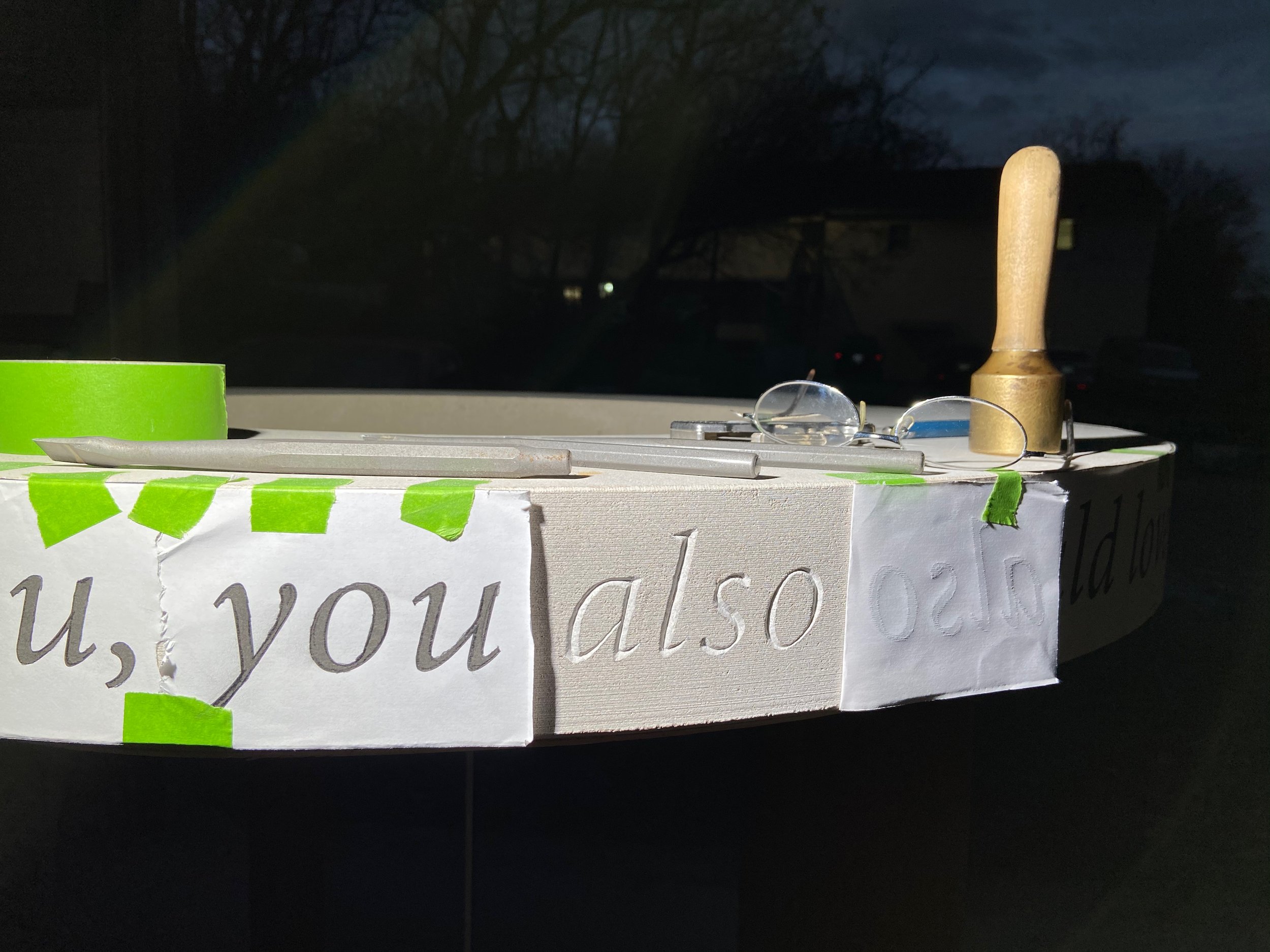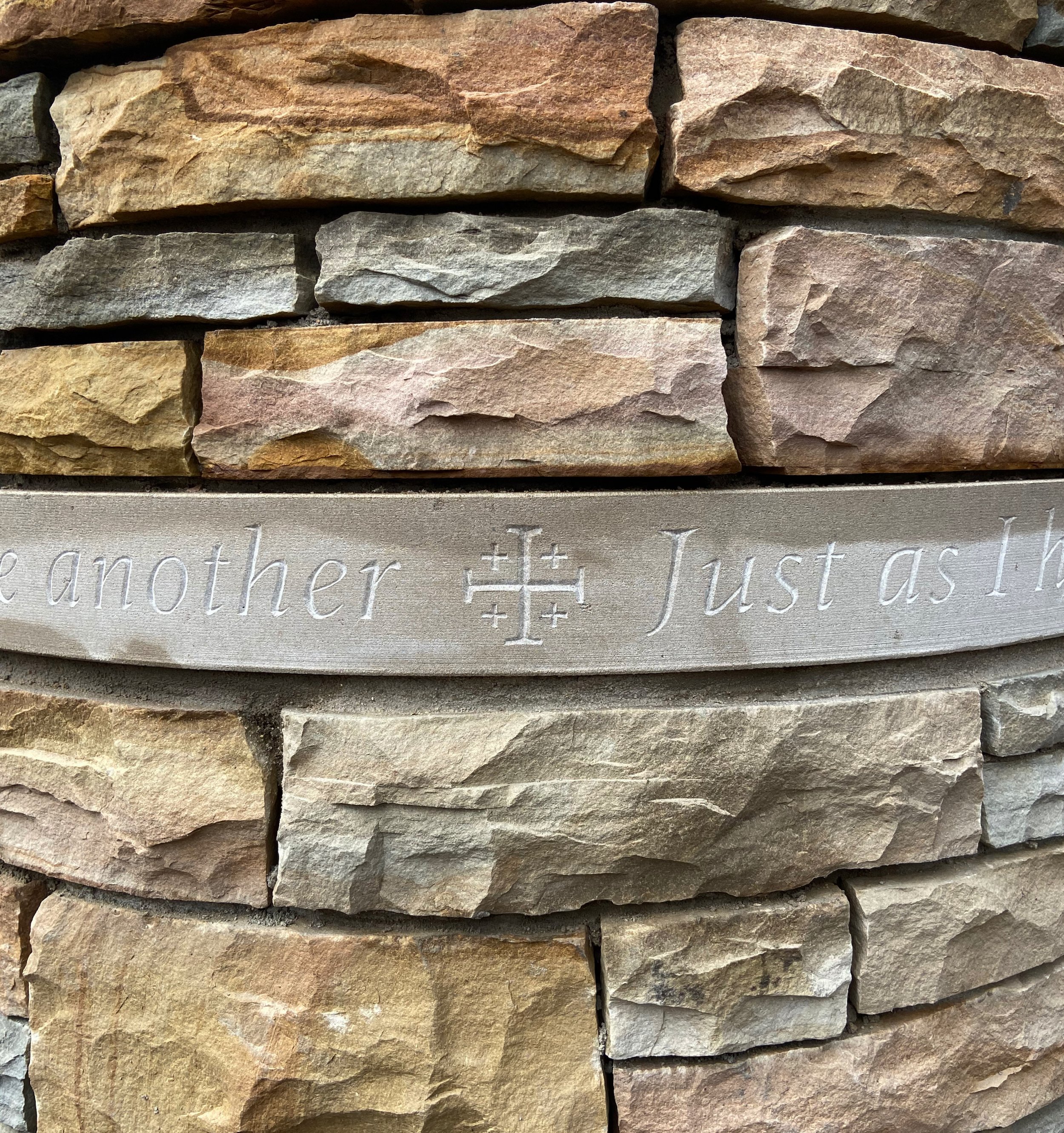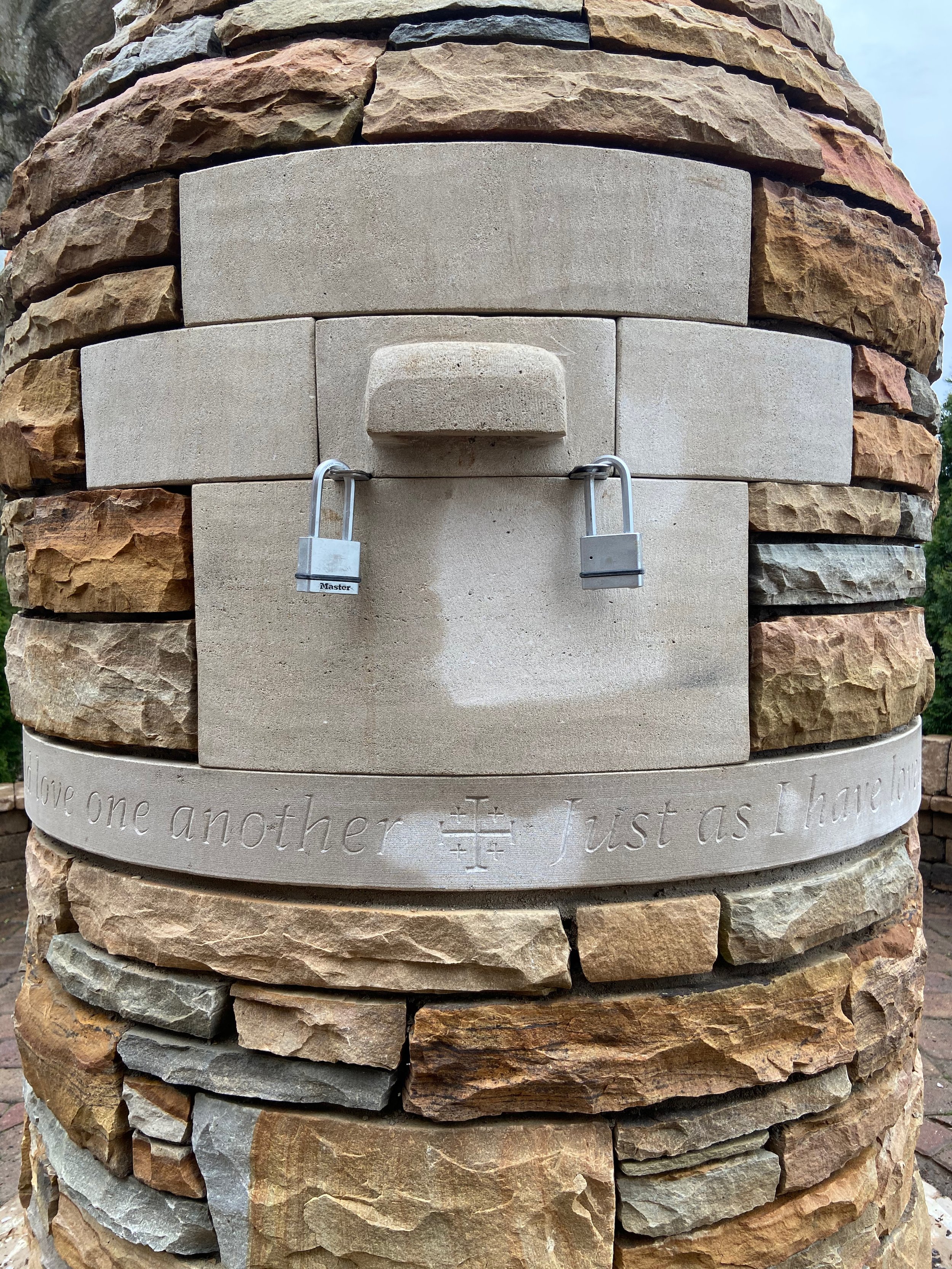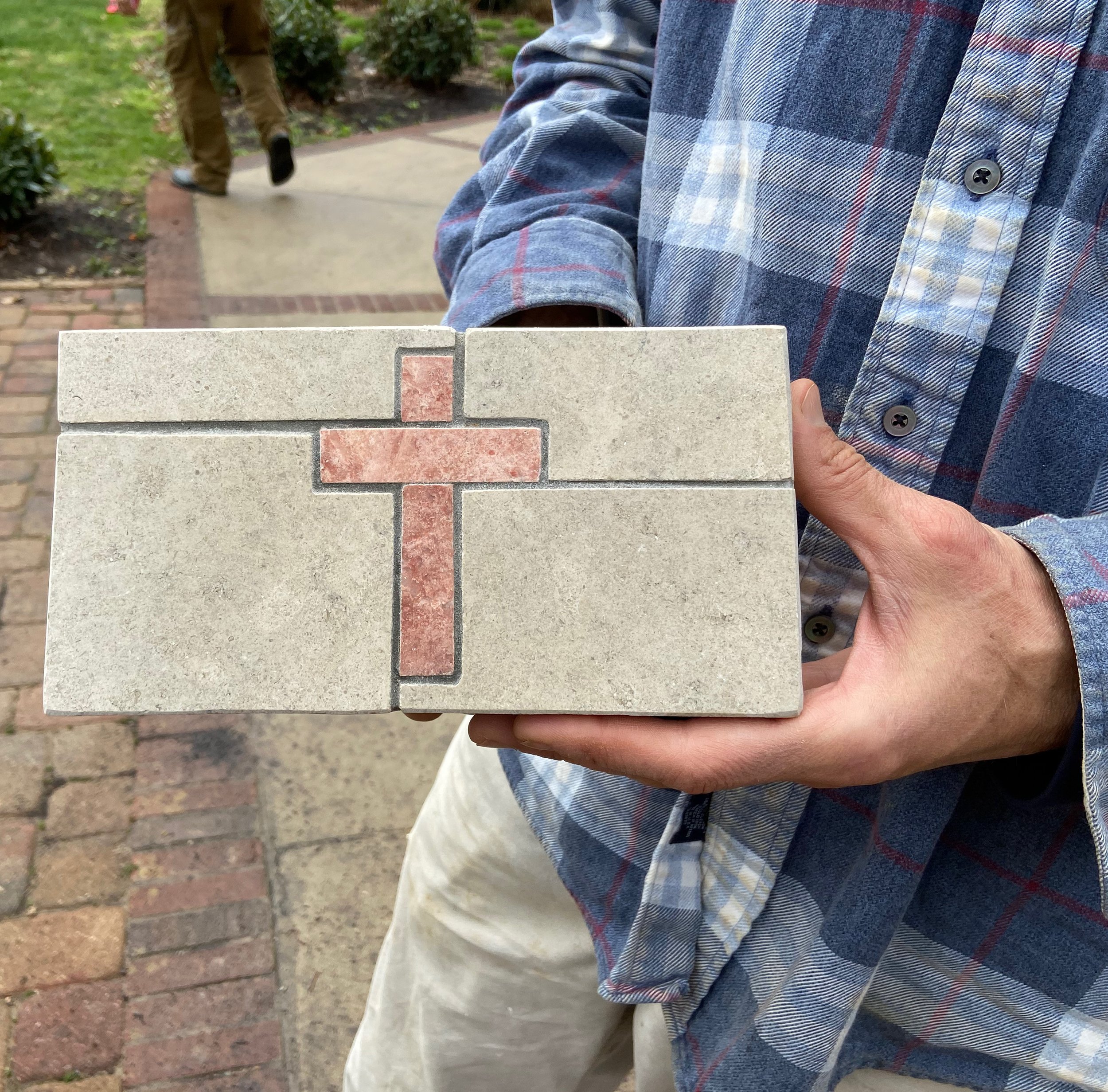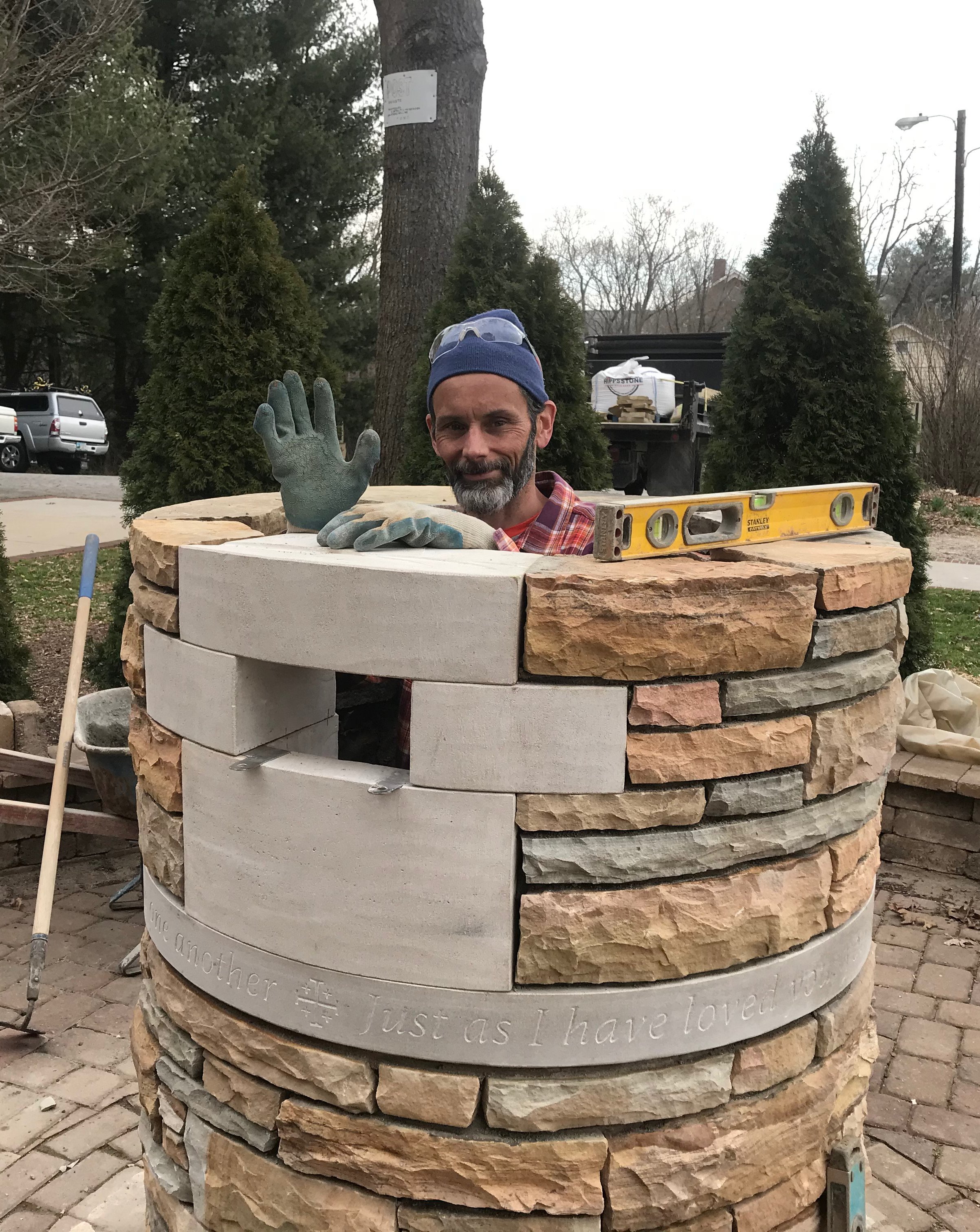A Communal Urn / Ash Vault
A shop presentation of the Communal Urn, a stone vault in process.
On September 4th of 2020, I hosted a client at my shop to discuss an unusual project I am working on. A local church has commissioned me to create a communal urn, a stone vault for the cremated remains of members of their congregation. I am drawn to these types of unusual projects and I’m grateful that such work finds me.
I set up my “presentation“ in the lower shop – the same place I hosted last fall’s studio tour. In fact, in the background of the picture you can see “The Boy With Antlers“ mosaic, which has been hanging there for almost a year now.
To the middle left of the photo is a full-scale print out of the vault. It’s just over 4 feet tall and 42 inches across. I am a big fan of full scale templates, at least when contemplating something new or unusual. It’s easier to critique the design at full size. About halfway up the urn there is an inscription, noted in my drawing with scribbles. While the exact quote has not been completely nailed down yet, the basic concept is that the inscription is in a single piece of stone, which I am calling the donut. I’ve already had that piece fabricated by my friends at Tennessee Marble Company. It’s resting on the pallet just behind the poster. The donut hole has been cut out; the Styrofoam was to prevent it from moving during transit. Originally a scrap piece, I believe the donut hole will now factor into the completed vault, possibly as the cap.
To the right there is a pallet of Tennessee sandstone. You can’t really tell from this picture, but those pieces have a 21 inch radius on them. Those will make up the body of the vault. We have been making these pieces here and there at the shop, when we have a few idle moments. We’ll need a bunch more, but it’s a good start.
Communal Urn Vault Opening with ‘door’ closed.
In the background, stretched out on the floor is a poster with the possible inscription laid out in multiple typefaces. It’s 11 feet long! That’s a lot a letter carving. In the foreground are some samples and even a comparison between sandblasting and letter carving. I’m excited that they are going to let me carve the inscription. I am not a super skilled letter carver, but it just seems appropriate in this context for this inscription to be done by hand. This will make me a better letter carver. Or completely insane.
UPDATE OCTOBER 5, 2020
I’m still pecking away at the opening to the communal urn. I have the major pieces done, though I still have to cut a ramp into the big bottom stone. I thinned down the door again, so it’s very manageable weight now. I still need to devise a locking mechanism, but that will be easier now that I have the whole thing in place to look at. I like it. It’s fun to make things I’ve never made before.
The completed Communal Urn and Ash Vault at Trinity United Methodist Church in West Asheville, NC.
UPDATE MARCH 21, 2021
Design
I have to admit I was not familiar with the concept of a communal urn before the pastor of the church approached me. She had come across a brick structure at another church and wanted to commission something similar. I did not care for the brick urn, which was square and had a flat top. To me, it looked like a bear proof garbage can in a state park. Plus, we don’t work with brick!
My design is cylindrical. This reduces the interior volume, but a circle feels more appropriate to an artifact such as this, meant to celebrate the cycle of life. An early iteration of the design resembled an acorn, which was metaphoric, but too expensive.
The final shape resembles a cairn, a stack of stones usually found somewhere in the woods. They are sometimes used as way-finders, markers the show the path to follow. That seemed an apt metaphor as well. Artist Andy Goldsworthy has built many similar structures that he calls seeds. They are arresting structures that make one pause and reflect. Cairns are typically laid stone on stone, with no mortar. They aren’t usually hollow though. The urn is built of Tennessee sandstone with 9” thick mortared walls and a void within. The whole thing is 42” in diameter.
THE DONUT: LETTERS CARVED IN STONE
The key design piece is a single piece of limestone located about halfway up the urn. We referred to it as “the donut” because of the opening in the center to allow the ashes to fall through. The stone features an inscription selected by the congregation. The inscription repeats twice. “Just as I have loved you, you also should love one another.” I had imagined some type of circular phrase that looped back onto itself, but couldn’t think of one!
Lettering carved into limestone ‘donut’ for the communal urn
I had a piece of Indiana limestone cut for me by Tennessee Marble Company. I chose limestone because it is relatively easy to carve. As it turns out, there are architectural details made from Indiana limestone in the church building itself. I decided to do the letter carving myself. I have dabbled with this in the past, but this was my largest project by far. It came out pretty well I think. Incised letters like this have more character than the sandblasted lettering most commonly seen today. I had a special table made to support the stone at chest height. I had a powerful lamp and a space heater nearby, so I was able to work on it throughout the winter. It took a long time!
THE RAMP AND THE DOOR
Ashes have to get into the vault somehow. I had a couple of random blocks of the same kind of limestone that I used to create a portal. There’s a ramp cut into the big piece at the bottom. The ramp rests right on top of the engraved donut stone.
I ended up making THREE doors for this thing. I broke the first one drilling holes to fasten the locking mechanism in place. I made an exact copy of that (in a fraction of the time, since I had already figured it out during the first go round.) Then I decided to make the drawer handle out of stone rather than an added piece of steel hardware. The third and final iteration is all one stone with a small indentation underneath for grip. The door is heavy but will rarely be removed. I made a small mosaic on the backside of the door. A cross faces into the vault where ashes shall be interred. This watches over everyone’s remains. It also hides the hardware used to mount the locking mechanism.
THE DOME
Creepy, but it does show the depth of the thing.
The dome is not self-supporting, though we toyed with that idea. Just above the ramp, we put a single piece of stone to seal off the vault area. More than anything else, that prevented extra mortar from falling into the hole and reducing the volume of the vault. At one point I climbed into the cylinder to clean it out. Tight fit! So the dome stones all sit on that interior cap and the space is filled with mortar and chips. I admit that I got so focused on the donut and door that I didn’t think through the cap in enough detail. I like it but it took forever and I can imagine a better process and product for the next time.
It was a fun and challenging project and I like the results. It’s unlike anything I’d ever built before. Those are the most fun! And crazy-making!







